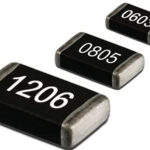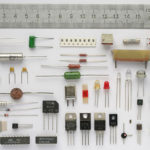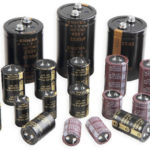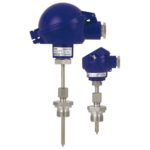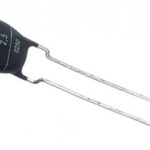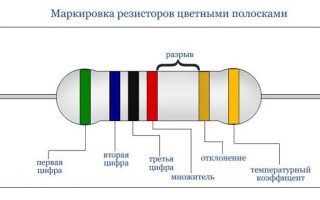ResistorEspecially a small resistor is a small-sized radio element. But marking the nominal value on it is necessary. This is especially important in industrial applications. If an amateur radio technician in a home laboratory can check each resistor, there is no such possibility in production. Small (0.125 W or 0.25 W) resistors used to be marked with small numbers, which were not easy to read. And technologically it is difficult to put such a marking. Therefore, many manufacturers began to switch to a coded designation of the rating of the lead device with colored strips or dots. The second option is not widespread, and the first turned out to be convenient for manufacturers, so it caught on. Nowadays even large resistors (up to several watts) are marked this way.
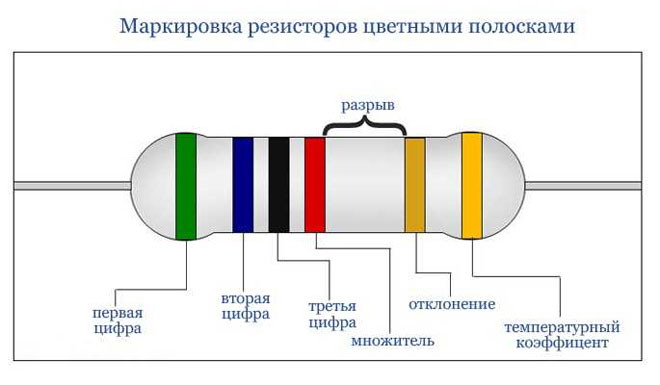
Content
Number and purpose of colored bars on a resistor
The basic characteristics of a resistor include:
- power (in watts);
- nominal resistance (in ohms);
- accuracy (variation from the nominal value in per cent);
- Temperature coefficient of resistance - the relative change in resistance when the temperature changes (measured in ppm/°C - how many parts per millionths (part per million) of the nominal value will change the resistance of the resistor when the temperature changes by 1 degree Celsius).
The first parameter in the list is determined by the size of the element. The bigger the size, the more thermal power it can dissipate during operation. The other characteristics are marked with colored ring stripes along the case.
A large part of the designation is the nominal resistance of the device - it consists of two or three rings indicating numbers and one stripe indicating the multiplier by which the first value must be multiplied. A total of 3 to 6 stripes can be applied to the resistor:
- three bands are applied to resistors with an error of up to 20% (the least accurate) - two rings denote the digits of the rating, and the third gives information about the multiplier (the accuracy in this case is not indicated);
- four rings - all as in the previous variant, but the error requirements are stricter - from 10% and less (in most cases, four bands have resistance accuracy classes of ±10 % and ±5 %);
- five bands - as in the case of four, but the nominal digits are indicated by three rings, followed by a decimal multiplier and a scatter band (2.5 % or less);
- six rings have high-precision resistors, designed to work in difficult conditions, in addition to the previous option has an additional band indicating the temperature coefficient of resistance.
Important! There are resistors marked with one black band. Their resistance is zero, they serve as jumpers on the printed circuit board. The use of such resistors is due to the peculiarities of PCB topology and the technology of manufacturing electronic devices in industrial conditions.
Key figures
The figures show the nominal value of the resistor without taking the multiplier into account. For example, a device with a resistance of 10 Ohm, 100 Ohm, 1 kOhm, 10 kOhm, etc. will have the first two digits in the same color, brown, then black. The more precise elements, which often have fractional ratings (for example, 10.2 ohms), use three digits (three bars) for this category.
You can use tables that are available in reference books or on the Internet to determine color values. But it is more convenient to use special calculators. Previously, they were used in the form of programs that had to be downloaded to your computer. Now online calculators are widely used. They allow you to sequentially enter the colors in the form, without worrying about remembering the previous numbers and eventually get the desired value of resistance.
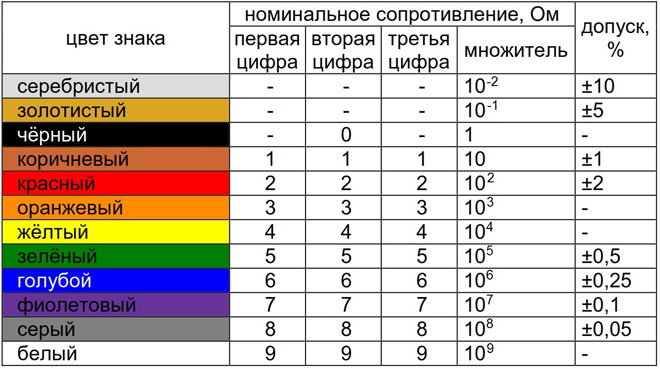
In practice, there is a problem. Some manufacturers, especially little-known ones, use dyes of colors that are hard to identify. And if gray from silver can be distinguished by the location of the ring, the completely obscure shades often do not allow to distinguish yellow from orange or red from brown. A possible reason for this approach is to save on the cost of paint. The only way out in such a case is to measure the resistance directly with a tester.
Multiplier x10
To distinguish, as mentioned above, 10 ohms from 10 kilohms, there is another parameter in the labeling - the decimal multiplier. It shows by what to multiply the result obtained in the previous step. So, if the third band out of four is black, the multiplier is 1 and the total result is 10 ohms. But if this ring is orange, then multiply by 1000, and the total is 10 kOhms. The range of this parameter is 0.01 to 109, 11 colors are used to encode the entire range. For convenience, each color is often indicated not by a decimal multiplier, but by a decimal multiple of a unit prefix. For example, green means that the value should be multiplied by 100 kOhm (by 10000), and blue means 1 MOhm (multiplied by a million).
Permissible deviation from nominal value in %
This parameter indicates how much the actual resistance value may differ from the declared value. Thus, at 10% variation, the resistance of 10-kilohm element can have a value in the range from 90 to 110 kOhm. For many tasks in household and amateur equipment such accuracy is quite sufficient, and most devices on the market are within this error.
But for measuring equipment, this variation is already too large. Even a difference of 5% is not always enough. Therefore, for such purposes resistors with a variation of 2% and higher are used. A separate strip is allocated to mark this parameter. The color from silver to gray means a spread of ±10% to ±0,05%.
Temperature coefficient of resistance in ppm/°C
In the home laboratory, and in household appliances, the probability of using rather expensive resistors, for which this parameter is important, is small. But in demanding applications where stable operation under temperature changes is important, information about the resistor's response to heating or cooling can be critical. And for high-precision resistors there is a sixth bar, on the far right, indicating the TCS. There are seven colors for it - for coefficients from 1 to 100 in ascending order. Factor 1 means that when heated by 1 °C, the resistance will change by one-millionth of the rating, that is, by one ten-thousandth of a percent.
Which side to count the stripes on a resistor
To determine the rating, a resistor's markings are read from left to right. The resistor body is symmetrical, so it sometimes takes time to determine the sides. The search algorithm is as follows:
- if there is a silver or gold band on the case, it is always on the right (if space permits, it is marked a little to the side);
- If space permits, the rings are always moved toward the left side;
- sometimes the first band is wider than the others;
- if the above signs are absent, you can try to read the marking in one direction, then in the other - it may turn out that in one direction the denomination cannot be determined (for example, black color is not applied for TCS).
If none of the methods helped, the only thing left is to Measure resistance with a multimeter.
Resistor marking calculator with colored bars
Rows of Preferred Values for Resistors
Resistors are available with ratings that correspond to series of preferred values. These series are defined by standards adopted in many countries in accordance with international agreements (IEC 63-53).
In Russia such a standard is GOST 28884-90. It provides for production of resistors in E3, E6, E12, E24, E48, E96 and E192 series. Rows differ from each other by the step of values (which should be multiplied by the decimal coefficient). And the step depends on the permissible deviation, which decreases with increasing numerical index. So, the smallest error (0,5%, 0,25% and 0,1%) and the smallest step of nominal values have resistors from E192 series.
Rows with a smaller index are obtained by crossing out even values from the highest row. And the lowest accuracy (20%) and the largest step have rows E3 and E6. The latter contains only 3 nominals. And it is logical - there is no sense in a small step, if the next value does not go beyond the allowable range. You can read about the filling of the rows by reading the GOST. You can download it on the Internet.
Table 1. Preferred rows for E24, E12, E6, E3 resistors.
| Е24 | Е12 | E6 | Е3 |
|---|---|---|---|
| Tolerance ±5% | Tolerance ±10% | 10% tolerance | Tolerance ±20% |
| 1,0 | 1,0 | 1,0 | 1,0 |
| 1,1 | |||
| 1,2 | 1,2 | ||
| 1,3 | |||
| 1,5 | 1,5 | 1,5 | |
| 1,6 | |||
| 1,8 | 1,8 | ||
| 2,0 | |||
| 2,2 | 2,2 | 2,2 | 2,2 |
| 2,4 | |||
| 2,7 | 2,7 | ||
| 3,0 | |||
| 3,3 | 3,3 | 3,3 | |
| 3,6 | |||
| 3,9 | 3,9 | ||
| 4,3 | |||
| 4,7 | 4,7 | 4,7 | 4,7 |
| 5,1 | |||
| 5,6 | 5,6 | ||
| 6,2 | |||
| 6,8 | 6,8 | 6,8 | |
| 7,5 | |||
| 8,2 | 8,2 | ||
| 9,1 |
Table 2. Rows of preferred values for resistors with tight tolerances E192, E96, E48.
| Е192 | Е96 | Е48 |
|---|---|---|
| 100 | 100 | 100 |
| 101 | ||
| 102 | 102 | |
| 104 | ||
| 105 | 105 | 105 |
| 106 | ||
| 107 | 107 | |
| 109 | ||
| 110 | 110 | 110 |
| 111 | ||
| 113 | 113 | |
| 114 | ||
| 115 | 115 | 115 |
| 117 | ||
| 118 | 118 | |
| 120 | ||
| 121 | 121 | 121 |
| 123 | ||
| 124 | 124 | |
| 126 | ||
| 127 | 127 | 127 |
| 129 | ||
| 130 | 130 | |
| 132 | ||
| 133 | 133 | 133 |
| 135 | ||
| 137 | 137 | |
| 138 | ||
| 140 | 140 | 140 |
| 142 | ||
| 143 | 143 | |
| 145 | ||
| 147 | 147 | 147 |
| 149 | ||
| 150 | 150 | |
| 152 | ||
| 154 | 154 | 154 |
| 156 | ||
| 158 | 158 | |
| 160 | ||
| 162 | 162 | 162 |
| 164 | ||
| 165 | 165 | |
| 167 | ||
| 169 | 169 | 169 |
| 172 | ||
| 174 | 174 | |
| 176 | ||
| 178 | 178 | 178 |
| 180 | ||
| 182 | 182 | |
| 184 | ||
| 187 | 187 | 187 |
| 189 | ||
| 191 | 191 | |
| 193 | ||
| 196 | 196 | 196 |
| 198 | ||
| 200 | 200 | |
| 203 | ||
| 205 | 205 | 205 |
| 208 | ||
| 210 | 210 | |
| 213 | ||
| 215 | 215 | 215 |
| 218 | ||
| 221 | 221 | |
| 223 | ||
| 226 | 226 | 226 |
| 229 | ||
| 232 | 232 | |
| 234 | ||
| 237 | 237 | 237 |
| 240 | ||
| 243 | 243 | |
| 246 | ||
| 249 | 249 | 249 |
| 252 | ||
| 255 | 255 | |
| 258 | ||
| 261 | 261 | 261 |
| 264 | ||
| 267 | 267 | |
| 271 | ||
| 274 | 274 | 274 |
| 277 | ||
| 280 | 280 | |
| 284 | ||
| 287 | 287 | 287 |
| 291 | ||
| 294 | 294 | |
| 298 | ||
| 301 | 301 | 301 |
| 305 | ||
| 309 | 309 | |
| 312 | ||
| 316 | 316 | 316 |
| 320 | ||
| 324 | 324 | |
| 328 | ||
| 332 | 332 | 332 |
| 336 | ||
| 340 | 340 | |
| 344 | ||
| 348 | 348 | 348 |
| 352 | ||
| 357 | 357 | |
| 361 | ||
| 365 | 365 | 365 |
| 370 | ||
| 374 | 374 | |
| 379 | ||
| 383 | 383 | 383 |
| 388 | ||
| 392 | 392 | |
| 397 | ||
| 402 | 402 | 402 |
| 407 | ||
| 412 | 412 | |
| 417 | ||
| 422 | 422 | 422 |
| 427 | ||
| 432 | 432 | |
| 437 | ||
| 442 | 442 | 442 |
| 448 | ||
| 453 | 453 | |
| 459 | ||
| 464 | 464 | 464 |
| 470 | ||
| 475 | 475 | |
| 481 | ||
| 487 | 487 | 487 |
| 493 | ||
| 499 | 499 | |
| 505 | ||
| 511 | 511 | 511 |
| 517 | ||
| 523 | 523 | |
| 530 | ||
| 536 | 536 | 536 |
| 542 | ||
| 549 | 549 | |
| 556 | ||
| 562 | 562 | 562 |
| 569 | ||
| 576 | 576 | |
| 583 | ||
| 590 | 590 | 590 |
| 597 | ||
| 604 | 604 | |
| 612 | ||
| 619 | 619 | 619 |
| 626 | ||
| 634 | 634 | |
| 642 | ||
| 649 | 649 | 649 |
| 657 | ||
| 665 | 665 | |
| 673 | ||
| 681 | 681 | 681 |
| 690 | ||
| 698 | 698 | |
| 706 | ||
| 715 | 715 | 715 |
| 723 | ||
| 732 | 732 | |
| 741 | ||
| 750 | 750 | 750 |
| 759 | ||
| 768 | 768 | |
| 777 | ||
| 787 | 787 | 787 |
| 796 | ||
| 806 | 806 | |
| 816 | ||
| 825 | 825 | 825 |
| 835 | ||
| 845 | 845 | |
| 856 | ||
| 866 | 866 | 866 |
| 876 | ||
| 887 | 887 | |
| 898 | ||
| 909 | 909 | 909 |
| 920 | ||
| 931 | 931 | |
| 942 | ||
| 953 | 953 | 953 |
| 965 | ||
| 976 | 976 | |
| 988 |

